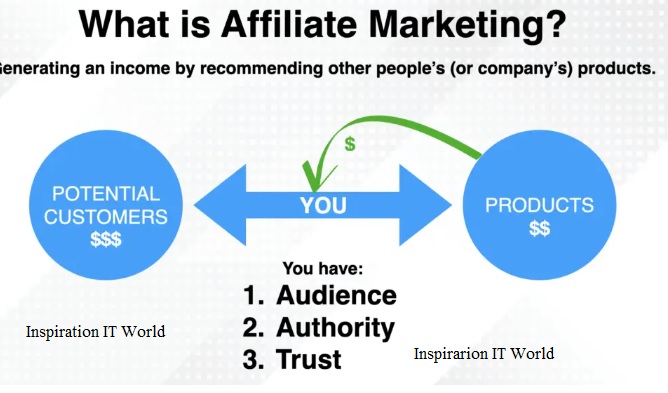
Affiliate marketing Guide is a popular method for individuals and businesses to earn money online by promoting products or services offered by other companies. It’s a performance-based marketing strategy where affiliates, often referred to as partners, earn a commission for every sale, lead, or action generated through their marketing efforts.
What is Affiliate Marketing Guide?
At its core, affiliate marketing involves three main parties:
- The Merchant (Advertiser/Brand): This is the company or individual that creates the product or service. They provide the affiliate program and pay commissions for sales or leads generated.
- The Affiliate (Publisher/Marketer): This is the individual or company that promotes the merchant’s products or services. Affiliates use various marketing channels, such as blogs, social media, email, and websites, to attract potential customers.
- The Consumer: The end-user who sees the affiliate’s marketing efforts, clicks on the affiliate link, and makes a purchase or completes a desired action.
Affiliate Marketing Market place
How Does Affiliate Marketing Guide Work?
The affiliate marketing process is straightforward:
- Affiliate Joins a Program: An affiliate chooses a program that aligns with their niche or audience. This could be through an affiliate network (like Amazon Associates, ShareASale, or ClickBank) or directly with a brand.
- Promote the Products: The affiliate uses unique tracking links provided by the merchant to promote the products or services. These links ensure that sales or actions are attributed to the correct affiliate.
- Generate Traffic: Affiliates drive traffic to the merchant’s website through various online marketing techniques, including content creation, SEO, paid advertising, and social media.
- Earn Commissions: When a consumer makes a purchase or completes a specific action (like signing up for a newsletter) through the affiliate’s link, the affiliate earns a commission. The commission structure varies by program and can be a percentage of the sale or a fixed amount.
Types of Affiliate Marketing Models
- Pay-Per-Sale (PPS): The most common model where the affiliate earns a commission for each sale generated.
- Pay-Per-Lead (PPL): Affiliates earn money when they refer leads, such as sign-ups or trial users, rather than actual sales.
- Pay-Per-Click (PPC): Affiliates get paid based on the number of clicks generated through their affiliate links, regardless of whether the clicks result in a sale.
- Pay-Per-Install (PPI): This model is common in mobile apps, where affiliates earn a commission every time a user installs an app through their referral link.
Advantages of Affiliate Marketing
- Low Start-Up Costs: Affiliate marketing doesn’t require you to create products, manage inventory, or handle customer service. This makes it an attractive option for beginners with limited capital.
- Flexibility: Affiliates can choose from a wide range of products or services to promote, allowing them to work within a niche they are passionate about.
- Passive Income Potential: Once you’ve set up your affiliate marketing strategy, it can generate income with minimal ongoing effort, especially if you’re leveraging content marketing or SEO.
- Scalability: As your audience grows, so does your earning potential. Affiliates can scale their efforts by targeting new markets or expanding into different niches.
Challenges of Affiliate Marketing
- High Competition: Popular niches can be highly competitive, making it difficult for new affiliates to stand out.
- Dependence on Merchant Policies: Affiliates rely on the merchant’s affiliate program policies, which can change, impacting commission rates or payment structures.
- Need for Traffic: Generating a significant income requires a steady flow of traffic to the affiliate links, which can be challenging to achieve.
- Earning Delays: Some programs have delayed payment schedules, meaning you might wait weeks or months before receiving commissions.
Tips for Success in Affiliate Marketing
- Choose the Right Niche: Focus on a niche you are passionate about and that has a proven demand. This will make it easier to create engaging content and build a loyal audience.
- Build Trust with Your Audience: Transparency is key in affiliate marketing. Always disclose your affiliate relationships and only promote products you genuinely believe in.
- Focus on Content Quality: High-quality content that provides value to your audience is crucial for driving traffic and conversions. Invest time in creating detailed reviews, tutorials, and guides.
- Diversify Your Income Streams: Don’t rely on a single affiliate program. Diversify your income sources by joining multiple programs across different niches.
- Analyze and Optimize: Regularly review your affiliate marketing performance. Use analytics to understand what works and optimize your strategies accordingly.
Conclusion
Affiliate marketing is a powerful way to earn money online. Whether you’re looking to supplement your income or build a full-time business. By choosing the right niche, building trust with your audience, and focusing on high-quality content, you can create a sustainable income stream. As with any business venture, success in affiliate marketing requires patience, persistence, and continuous learning.
Contact: Inspiration IT World for Training
